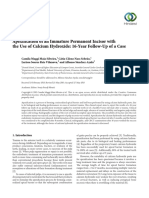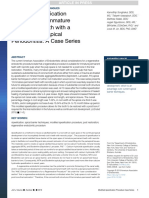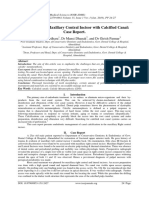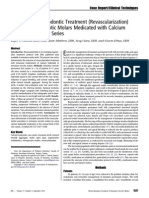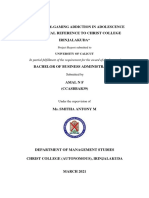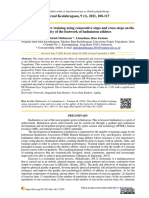Case Reports Annals and Essences of Dentistry
Case Reports Annals and Essences of Dentistry
Uploaded by
Sirisha KyCopyright:
Available Formats
Case Reports Annals and Essences of Dentistry
Case Reports Annals and Essences of Dentistry
Uploaded by
Sirisha KyOriginal Description:
Original Title
Copyright
Available Formats
Share this document
Did you find this document useful?
Is this content inappropriate?
Copyright:
Available Formats
Case Reports Annals and Essences of Dentistry
Case Reports Annals and Essences of Dentistry
Uploaded by
Sirisha KyCopyright:
Available Formats
Case reports Annals and Essences of Dentistry
NON SURGICAL ENDODONTIC RETREATMENT OF MAXILLARY CENTRAL INCISOR
HAVING BLUNDERBUSS APEX WITH MINERAL TRIOXIDE AGGREGATE (MTA).
*Sirisha K
* Professor, Department of Conservative dentistry and Endodontics, GITAM Dental College and Hospital, Visakhapatnam.
ABSTRACT
The teeth with immature apices pose a problem during obturation of root canal system. This article presents a case report of
failed endodontic treatment in maxillary central incisor with open apex. The obturating material was removed from root canal
system, root canal was cleaned, shaped and packed with calcium hydroxide and left for one week. In the second visit, root
canal system was thoroughly irrigated with sodium hypochlorite and a 3-4 mm of MTA plug was placed at the apical
terminus. The root canal system was sealed with thermoplasticized guttapercha. The access cavity was restored with
coronal radicular composite restoration. Six months follow up demonstrated clinically asymptomatic and adequately
functional tooth with radiographic signs of healing.
KEYWORDS : Apexification, MTA, blunderbuss apex.
INTRODUCTION
Most common causes of endodontic failures are The material was packed into the apical 2mm of the
inadequate cleaning and shaping and incomplete canal against which guttapercha was condensed
1 4
obturation . Teeth with incompletely formed apices (one appointment technique ).
pose problems during obturation of root canals due MTA has been advocated as a material to serve as
to wide open apical foramina. Attention should be an apical barrier for root end induction. In the MTA
focused on maintenance of vitality in these teeth so apical barrier technique, a 3 – 4 mm plug of MTA is
that as much root length and dentin formation as packed into the apical end of the canal. The canal is
possible can occur in the root. Vital pulp therapy then obturated with guttapercha after a period of 4-6
5
techniques like pulp capping and pulpotomy have hours . Advantages are MTA favors apexification
proved to be successful, since they aided by the and periapical healing regardless of the prior use of
tremendous blood supply present within the open calcium hydroxide paste. Other advantages are
apex. Determination of the extent of apical closure predictable apical closure, reduced treatment time
is many times more difficult to ascertain. and number of appointments and also radiographs.
Radiographic interpretation of apical closure is often
misleading since dental radiograph is a two Case report
2
dimensional picture of a three dimensional object . A 24 year old male patient reported to the dental
The use of calcium hydroxide for the apexification in office with a complaint of swelling in relation to
the pulpless tooth was first reported by Kaiser and it upper front tooth. He gave a history of previous root
3
was popularized by the work of Frank . The calcium canal treatment in relation to maxillary central
hydroxide can be used alone or it can be mixed with incisor two years ago. Detailed patient’s history
CMCP, metacresyl acetate, Cresanol (i.e. a mixture revealed childhood trauma to the upper front teeth.
of CMCP and metacrsyl acetate), physiologic saline, Vitality tests were performed to evaluate the pulpal
Ringer’s solution, distilled water and anesthetic status of adjacent teeth. Both the adjacent teeth
solution. The canal would ideally be completely responded normally to the cold stimulus and electric
filled with the paste but not overfilled. The usual pulp tester. Radiographic examination revealed an
time required to achieve apexification is 6 to 24 immature root apex in relation to #21 with
3
months (average 1 year +/- 7 months ). inadequately sealed root canal (Figure 1).
In the year 1975 Roberts and Brilliant reported the Retreatment of #21 was planned using MTA as
use of tricalcium phosphate as an apical barrier. apical barrier. After application of rubber dam, glass
Vol. - II Issue 3 July – Sept. 2010 86
Case reports Annals and Essences of Dentistry
ionomer restoration was removed from the access tissues creating foreign-body responses and
2
cavity and guttapercha was removed from the root compromising the apical seal .
canal using ‘file braided technique’ (Figure 2). The reduction of contaminants within the canal
Working length for the root canal was determined by instrumentation and medication and reduction of
(Figure 3). The canal was cleaned, shaped and root the canal space with a temporary resorbable
canal was sealed with a fresh mix of Ca(OH)2 paste were more important than the actual
cement. The access cavity was temporarily sealed dressing material used. The importance of apical
with reinforced Zinc Oxide Eugenol cement. seal was emphasized more than development of an
The patient was recalled after one week. The seal apical barrier for obtaining a satisfactory result. A
of the access cavity restoration was intact. There prospective clinical study showed a success rate of
was no percussion tenderness. The access cavity 100% for calcium hydroxide apexification, the mean
restoration was removed and the canal was time necessary for the formation of an apical barrier
6
irrigated with Sodium hypochlorite. MTA (ProRoot, being 12.19 months . Disadvantages are longer
Dentsply, Tulsa, OK) was mixed to a paste duration of the procedure and altered properties of
consistency according to manufacturer’s dentin. The Ca(OH)2 apexification treatment
recommendations, and packed into the apical third requires compliance from the patient and many
of the root canal with the help of MTA carrier appointments over a period of time ranging from 3
3
(Messing Gun- Produits Dentaires, Vevey, to 24 months . The fracture strength of immature
Switzerland) (Figure 4). A moist cotton pellet was teeth may be reduced by long-term calcium
7
placed in the root canal to hasten the setting hydroxide treatment .
reaction of MTA and sealed with reinforced Zinc A one-appointment procedure for obturating
Oxide Eugenol cement. permanent teeth with nonvital pulps and open
The patient was recalled after 6 hours and the apices was evaluated clinically. During nine months
remainder of the canal was sealed with of observation, the one-appointment treatment
thermoplasticised guttapercha(Figure 5). Patient using tricalcium phosphate or calcium hydroxide
was recalled after 1 week and the access as a substitute apical barrier was as effective
preparation was sealed with coronal radicular as the conventional multi-appointment technique
8
composite restoration (Figure 6). Four months that seeks a natural apical barrier .
follow up radiograph revealed partially healed To avoid the risk of fracture, a technique of one visit
periapical lesion. The tooth was asymptomatic and apexification was proposed in which an apical plug
9
clinically functional. of MTA was placed in the last 5mm of the canal .
Apexification in one visit by placing an apical plug of
Discussion MTA is a predictable and reproducible clinical
10
Endodontic management of the pulpless, procedure . Mineral trioxide aggregate is widely
permanent tooth with a wide, open blunderbuss used in procedures ranging from pulp capping to
11
apex has long presented a challenge to dentistry. furcal perforation repair . MTA consists of 50–75%
The treatment options used to be surgical approach, (wt) calcium oxide and 15–25% silicon dioxide.
apical closure technique and apical barrier These two components together comprise 70–95%
technique. Thermal tests are more reliable for of the cement. When these raw materials are
ascertaining vitality in immature pulpless teeth than blended they produce tricalcium silicate, dicalcium
radiographic methods and electric pulp vitality tests. silicate, tricalcium aluminate and tetra calcium
The presence of acute or chronic pain, percussion aluminoferrite. On addition of water the cement
12
sensitivity, mobility and discoloration of the crown hydrates to form silicate hydrate gel .
should be considered in the diagnosis. ‘Watch and After cleaning and shaping of root canal system, an
wait approach’ should be followed in case of apical plug of 3-5 mm MTA is placed and sealed
doubtful cases of pulp exposure. The main with a temporary restoration since it requires a time
challenge in performing root canal treatment in teeth period of 3-4 hours for completion of setting
with necrotic pulps and wide-open apices is to reaction. The rest of the canal is sealed with
13
obtain an optimal apical seal. The wide foramen thermoplasticized gutta-percha . MTA is highly
requires a large volume of filling material that may biocompatible. It has cementogenic, dentinogenic
extrude from the root canal into the periapical and osteogenic potential. Moisture and blood
contamination do not affect the sealing ability
Vol. - II Issue 3 July – Sept. 2010 87
Case reports Annals and Essences of Dentistry
Fig.2. Radiograph after
Fig.1.Preoperative
removal of Gutta percha
radiograph
Fig.3.Working length Fig.4. Radiograph with MTA
radiograph apical plug
Fig.5. Obturated Fig.6 .Coronalradicular
rootcanal Core of composite
Fig.7.RC preparation for
coronoradicular core
Vol. - II Issue 3 July – Sept. 2010 88
Case reports Annals and Essences of Dentistry
Main disadvantages are difficulty in manipulation filling material. Journal of Endodontics (1995) 21,
and longer setting time. MTA proves to be an ideal 349–53.
sealing material for teeth with open apices. 13. Shabahang S, Torabinejad M. Treatment of teeth
with open apices using mineral trioxide aggregate.
summary Pract Periodontics Aesthet Dent 2000; 12: 315 - 20.
This article presents a case of endodontically failed
maxillary central incisor with open apex which was
Corresponding Author :
successfully managed by using MTA as apical plug.
Dr K. sirisha
Door No. 7-5-148, Plot Number 23,
CONCLUSION
Ocean View Layout, Pandurangapuram,
MTA has wider range of clinical applications of
Visakhapatnam. Pin : 530003.
which, apexification is one among them. It has
Ph No: 0891 – 2522142,
additional advantages like biocompatibility and good
09848521749.
sealing ability.
E mail: sirishaky@gmail.com
References
1. John I.Ingle, James H. Simon, Pierre Machtou, and
Patrick Bogaerts. Outcome of endodontic treatment
and re-treatment
2. Rafter M. Apexification: a review. Dental
Traumatology (2005), 21, 1-8.
3. Frank A L, Therapy for the divergent pulpless tooth
by continued apical formation. Journal of American
Dental Association (1966) 72, 87-93.
4. Roberts, S.C., and Brilliant, J.D. Tricalcium
phosphate as an adjunct to apical closure in pulpless
permanent teeth. J Endod 1975;1:263.
5. Torabinejad M, Chivian N. Clinical applications of
mineral trioxide aggregate. JOE 1999;25:197-205.
6. Dominguez Reyes A, Munoz Munoz L, Aznar Martin
T Biological process Study of calcium hydroxide
apexification in 26 young permanent incisors. Dental
Traumatology (2005) 21, 141 - 5.
7. Andreasen J O, Farik B, Munksgaard E C, Long-term
calcium hydroxide as a root canal dressing may
increase risk of root fracture. DentalTraumatology
(2002) 18,134ñ7.
8. Coviello J, Brilliant JD. A preliminary clinical study on
the use of tricalcium phosphate as an apical barrier.
JOE 1979; 5: 6-13
9. Witherspoon D E, Ham K. One-visit apexification
technique for inducing root-end barrier formation in
apical closures. Practical Periodontics and Aesthetic
Dentistry (2001) 13, 455-60.
10.S. Simon , F. Rilliard , A. Berdal & P. Machtou. The
use of mineral trioxide aggregate in one-visit
apexification treatment : a prospective study.
International Endodontic Journal, (2007) 40, 186 –
197
11.Torabinejad M, Watson T F, PittFord T R. Sealing
ability of a mineral trioxide aggregate when used as a
root end filling material. Journal of Endodontics
(1993) 19, 591-595.
12.Torabinejad M, Hong C U, Mc Donald F, PittFord T R
Physical and chemical properties of a new root-end
Vol. - II Issue 3 July – Sept. 2010 89
You might also like
- Prepsa 2022Document840 pagesPrepsa 2022Tarek yahia100% (3)
- ROA Scopin 2014 4Document24 pagesROA Scopin 2014 4Patrick Castillo SalazarNo ratings yet
- Adhesive Restoration of Endodontically Treated TeethFrom EverandAdhesive Restoration of Endodontically Treated TeethRating: 3 out of 5 stars3/5 (2)
- Article 1603861587Document7 pagesArticle 1603861587Nathania AstriaNo ratings yet
- Single Visit Mta Apexification Technique For Formation of Root-End Barrier in Open Apices-A Case SeriesDocument7 pagesSingle Visit Mta Apexification Technique For Formation of Root-End Barrier in Open Apices-A Case Seriesdrvivek reddyNo ratings yet
- Case Report Single Visit Apexification Technique by Root End Barrier Formation With MTADocument5 pagesCase Report Single Visit Apexification Technique by Root End Barrier Formation With MTAanna handayaniNo ratings yet
- International Journal of Research in Dentistry: Single Sitting Apexification Treatment With Mta Apical Plugs: A CaseDocument4 pagesInternational Journal of Research in Dentistry: Single Sitting Apexification Treatment With Mta Apical Plugs: A CaseirfanaNo ratings yet
- Management of Maxillary Anterior Tooth With Open Apex by MTA ApexificationDocument3 pagesManagement of Maxillary Anterior Tooth With Open Apex by MTA ApexificationInternational Journal of Innovative Science and Research TechnologyNo ratings yet
- Ojsadmin, 1337Document6 pagesOjsadmin, 1337mgmdch consendoNo ratings yet
- Jurnal Ikga Kelompok 1 PDFDocument7 pagesJurnal Ikga Kelompok 1 PDFCita ChotimahNo ratings yet
- Clinical Management of Severe External Root Resorption: T C K Y A C C P LDocument6 pagesClinical Management of Severe External Root Resorption: T C K Y A C C P LNevena SaulicNo ratings yet
- Management of Blunderbuss CanalsDocument11 pagesManagement of Blunderbuss CanalsNitesh PatilNo ratings yet
- 10 1016@j Joen 2019 10 009Document8 pages10 1016@j Joen 2019 10 009fatimahNo ratings yet
- Biodentine-A Novel Dentinal Substitute For Single Visit ApexificationDocument6 pagesBiodentine-A Novel Dentinal Substitute For Single Visit ApexificationGurudutt NayakNo ratings yet
- Management of Open Apex With BiodentinDocument7 pagesManagement of Open Apex With BiodentinJessicaLisaNugrohoNo ratings yet
- Pediatric DentistryDocument61 pagesPediatric Dentistryabdomahmouid75No ratings yet
- Usage of White MTA in A Non-Vital Primary Molar With No Permanent SuccessorDocument4 pagesUsage of White MTA in A Non-Vital Primary Molar With No Permanent Successorsümeyra akkoçNo ratings yet
- Endodontic Retreatment of Maxillary Incisors Previously Treated With A Conventional Apexification Protocol: A Case ReportDocument5 pagesEndodontic Retreatment of Maxillary Incisors Previously Treated With A Conventional Apexification Protocol: A Case ReportTaufiqurrahman Abdul DjabbarNo ratings yet
- Sjodr 2243 48Document6 pagesSjodr 2243 48fatimahNo ratings yet
- Management of Open ApexDocument7 pagesManagement of Open ApexMineet KaulNo ratings yet
- Apexification With Calcium Hydroxide and Mineral Trioxide AggregateDocument5 pagesApexification With Calcium Hydroxide and Mineral Trioxide AggregateTalitha NabilaNo ratings yet
- Enhancing Fracture Resistance in Coronal Structure of Endodontically Treated Teeth by Placing Horizontal Posts in Buccolingual Direction: Case ReportDocument5 pagesEnhancing Fracture Resistance in Coronal Structure of Endodontically Treated Teeth by Placing Horizontal Posts in Buccolingual Direction: Case ReportInternational Journal of Innovative Science and Research TechnologyNo ratings yet
- Presented by P. Fazilram CRIDocument18 pagesPresented by P. Fazilram CRIdennisNo ratings yet
- Jurnal KasusDocument4 pagesJurnal KasusDena SeptianiNo ratings yet
- Apexification and ApexogenesisDocument32 pagesApexification and ApexogenesisRajneesh JindalNo ratings yet
- ContempClinDent36264-4657779 125617Document5 pagesContempClinDent36264-4657779 125617Clive LiuNo ratings yet
- Apexogenesis of A Symptomatic MolarDocument5 pagesApexogenesis of A Symptomatic MolarFoysal SirazeeNo ratings yet
- Nonsurgical RetreatmentDocument4 pagesNonsurgical RetreatmentNia LieantoNo ratings yet
- Clinical Applications of Biodentine: A Case Series: Ase EportDocument5 pagesClinical Applications of Biodentine: A Case Series: Ase EportpoojaNo ratings yet
- 1994 1524551201 PDFDocument4 pages1994 1524551201 PDFRizki AmeliaNo ratings yet
- Enhanced Retention of A Maxillofacial Prosthetic Obturator Using Precision Attachments: Two Case ReportsDocument6 pagesEnhanced Retention of A Maxillofacial Prosthetic Obturator Using Precision Attachments: Two Case ReportsAmalorNo ratings yet
- Endodontic ManagementDocument5 pagesEndodontic ManagementAnamika SinhaNo ratings yet
- Castellucci 1995Document4 pagesCastellucci 1995Jing XueNo ratings yet
- Apexification 07.03.22Document10 pagesApexification 07.03.22Shreya KediaNo ratings yet
- Konser JossDocument7 pagesKonser JossPascalis Adhi KurniawanNo ratings yet
- Endodontic Treatment With MTA Apical Plugs: A Case Report: Journal of Oral Science January 2008Document6 pagesEndodontic Treatment With MTA Apical Plugs: A Case Report: Journal of Oral Science January 2008Zefanya Cornelia SimorangkirNo ratings yet
- Evaluation of The Apical Sealing Ability of Remaining Gutta-Percha After Fiber Post PlacementDocument7 pagesEvaluation of The Apical Sealing Ability of Remaining Gutta-Percha After Fiber Post PlacementArlinda LuziNo ratings yet
- management-of-calcified-canalDocument6 pagesmanagement-of-calcified-canallolalolaaswellNo ratings yet
- Regenerative EndodonticsDocument46 pagesRegenerative EndodonticsShameena KnNo ratings yet
- Intracanal MedicationDocument34 pagesIntracanal MedicationdentistdentistdentisNo ratings yet
- Efficacy of Spirally Filled Versus InjectedDocument4 pagesEfficacy of Spirally Filled Versus InjectedArturo Trejo VeraNo ratings yet
- 120 - Modern Perspectives in RC ObturationDocument14 pages120 - Modern Perspectives in RC ObturationLarissa ClipaciucNo ratings yet
- Prosthodontic Management of Dentate Maxillectomy Patient A Clinical Case ReportActa Marisiensis Seria MedicaDocument4 pagesProsthodontic Management of Dentate Maxillectomy Patient A Clinical Case ReportActa Marisiensis Seria MedicaSaniaNo ratings yet
- Anatomic Post and Core-A Novel Approach To Restore Flared Root Canals: A Case ReportDocument3 pagesAnatomic Post and Core-A Novel Approach To Restore Flared Root Canals: A Case ReportkinayungNo ratings yet
- Management of Non Vital Anterior Teeth With Open Apex: A Report of Two CasesDocument4 pagesManagement of Non Vital Anterior Teeth With Open Apex: A Report of Two CasesGracia Yodianvi PratiwiNo ratings yet
- Challenges in Regenerative Endodontics: A Case SeriesDocument6 pagesChallenges in Regenerative Endodontics: A Case SeriesDr.O.R.GANESAMURTHINo ratings yet
- Mona Ismail Arto, Sharif Mansoor: International Journal of Environment, Agriculture and BiotechnologyDocument5 pagesMona Ismail Arto, Sharif Mansoor: International Journal of Environment, Agriculture and BiotechnologyMamta AgarwalNo ratings yet
- Regenerative Endodontic Treatment (Revascularization)Document4 pagesRegenerative Endodontic Treatment (Revascularization)barcimNo ratings yet
- Reconstruction of Devital Teeth Using Direct Fiber-Reinforced Composite Resins: A Case ReportDocument7 pagesReconstruction of Devital Teeth Using Direct Fiber-Reinforced Composite Resins: A Case ReportAngga RanggaNo ratings yet
- Management of Recently Traumatized Maxillary Central Incisors by Partial Pulpotomy Using MTA: Case Reports With Two-Year Follow-UpDocument5 pagesManagement of Recently Traumatized Maxillary Central Incisors by Partial Pulpotomy Using MTA: Case Reports With Two-Year Follow-UpKevin Carmona TomyNo ratings yet
- Management of Open ApexDocument28 pagesManagement of Open Apexdiksha sinha100% (5)
- Endodontic Management of Open Apex Using Biodentine As A Novel Apical MatrixDocument4 pagesEndodontic Management of Open Apex Using Biodentine As A Novel Apical MatrixRuchi ShahNo ratings yet
- Modern Perspectives in Root Canal Obturation: 4 CE CreditsDocument14 pagesModern Perspectives in Root Canal Obturation: 4 CE CreditsBharath SumanNo ratings yet
- Revascularization of Immature Permanent Incisors After Severe Extrusive Luxation InjuryDocument10 pagesRevascularization of Immature Permanent Incisors After Severe Extrusive Luxation InjuryEduardo CarrielNo ratings yet
- Thermacol PDFDocument4 pagesThermacol PDFAli Faraz SiddiquiNo ratings yet
- Management of Calcified Root Canal: A Case ReportDocument4 pagesManagement of Calcified Root Canal: A Case ReportNguyễn Đức HoàngNo ratings yet
- One-Step Apexification in Immature Tooth Using Grey Mineral Trioxide Aggregate As An Apical Barrier and Autologus Platelet Rich Fibrin Membrane As An Internal Matrix - PMCDocument7 pagesOne-Step Apexification in Immature Tooth Using Grey Mineral Trioxide Aggregate As An Apical Barrier and Autologus Platelet Rich Fibrin Membrane As An Internal Matrix - PMCDr Abhigyan ShankarNo ratings yet
- Itmkg 3Document5 pagesItmkg 3Euginia YosephineNo ratings yet
- MTA Apical Plugs in The Treatment of Traumatized Immature Teeth With Large Periapical LesionsDocument4 pagesMTA Apical Plugs in The Treatment of Traumatized Immature Teeth With Large Periapical LesionsDaniel VivasNo ratings yet
- Short ImplantsFrom EverandShort ImplantsBoyd J. TomasettiNo ratings yet
- Star Trac E-TRx ManualDocument46 pagesStar Trac E-TRx ManualCleiton ProfetaNo ratings yet
- CCASBBAR39Document56 pagesCCASBBAR39Ramani HarshilkumarNo ratings yet
- GNED500 Group Assignment Group 1Document12 pagesGNED500 Group Assignment Group 1nazrul2748No ratings yet
- MDZ 400Document28 pagesMDZ 400mariano villavicencioNo ratings yet
- OR InstrumentsDocument56 pagesOR Instrumentssellyna SaidinNo ratings yet
- PIIS1542356522000349Document12 pagesPIIS1542356522000349AaNo ratings yet
- Experimental Design in Psychology - A Case Approach 9th Edition - Original PDF EbookDocument385 pagesExperimental Design in Psychology - A Case Approach 9th Edition - Original PDF Ebookldavis2021No ratings yet
- 22-00340 AU Formal ComplaintDocument6 pages22-00340 AU Formal ComplaintFergus BurnsNo ratings yet
- Canivianka Sachi Emmanuela Tobing - Magazine Article AssignmentDocument2 pagesCanivianka Sachi Emmanuela Tobing - Magazine Article Assignmentboenjamin.alexanderNo ratings yet
- Sit and Be Fit Neuropathy Exercise GuideDocument8 pagesSit and Be Fit Neuropathy Exercise Guidefitnesadvice11 blogspot comNo ratings yet
- Priority Improvement AreasDocument2 pagesPriority Improvement AreasJASMIN FAMANo ratings yet
- Fall Quality Work Protocol Summary SheetDocument2 pagesFall Quality Work Protocol Summary SheetChip ChaseNo ratings yet
- Contractor Pre-Qualification Assesment Sheet: Mandatory Aspects of Safety AwarenessDocument3 pagesContractor Pre-Qualification Assesment Sheet: Mandatory Aspects of Safety AwarenessAkash Kumar Gupta100% (1)
- Jurnal Keolahragaan, 9 (1), 2021, 108-117: Ahiriah Muthiarani, Lismadiana, Rina YunianaDocument10 pagesJurnal Keolahragaan, 9 (1), 2021, 108-117: Ahiriah Muthiarani, Lismadiana, Rina YunianaFadli IhsanNo ratings yet
- Non Preparation VeneersDocument24 pagesNon Preparation VeneersastinejenniferNo ratings yet
- Alvarado CV 2023octDocument8 pagesAlvarado CV 2023octapi-559892740No ratings yet
- FCPSDocument8 pagesFCPSDr MunawarNo ratings yet
- Crime and Intelligence Research - EditedDocument10 pagesCrime and Intelligence Research - EditedPaul WahomeNo ratings yet
- WOMEN EMPOWERMENT REPORT 2019-20 (1) - CompressedDocument83 pagesWOMEN EMPOWERMENT REPORT 2019-20 (1) - CompressedSibikshaNo ratings yet
- From Pregnancy To ParenthoodDocument29 pagesFrom Pregnancy To ParenthoodAreeba RashidNo ratings yet
- Being An Ethical ProducerDocument6 pagesBeing An Ethical ProducerJenise BurceNo ratings yet
- Special SenseDocument12 pagesSpecial SenseRoshan Jean PujanteNo ratings yet
- Int Endodontic J - 2022 - Meschi - Effectiveness of Revitalization in Treating Apical Periodontitis A Systematic ReviewDocument23 pagesInt Endodontic J - 2022 - Meschi - Effectiveness of Revitalization in Treating Apical Periodontitis A Systematic ReviewDhiaa AloweadatNo ratings yet
- Defects in Fermented Milk ProductsDocument15 pagesDefects in Fermented Milk ProductsDeepam Tandon AIFT, NoidaNo ratings yet
- Stunting Dan CariiesDocument5 pagesStunting Dan CariiessitoresmiNo ratings yet
- Ventricular Assist Devices: K. Nirmala SSN College of EngineeringDocument40 pagesVentricular Assist Devices: K. Nirmala SSN College of EngineeringNivetha RavikumarNo ratings yet
- INDIGENCY CertificateDocument1 pageINDIGENCY CertificateLj Oguing100% (1)
- What Inpatient Treatments Do We Have For Acute Intractable MigraineDocument3 pagesWhat Inpatient Treatments Do We Have For Acute Intractable Migrainetsiko111No ratings yet
- Module 1 - Organic ProductsDocument26 pagesModule 1 - Organic ProductsHamza AbdusetarNo ratings yet










